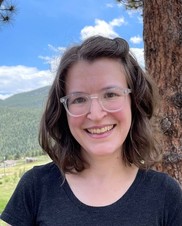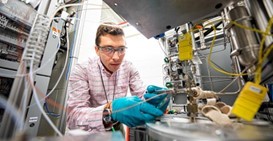|
|
Meet ChemCatBio's New Diversity, Equity, and Inclusion Team
Diversity, equity, and inclusion (DEI)—these values are at the center of the current administration and U.S. Department of Energy (DOE) Bioenergy Technologies Office (BETO) programs. DEI is also a motivating force for the Chemical Catalysis for Bioenergy Consortium (ChemCatBio), which launched its DEI strategy in 2019. Now, ChemCatBio aims to build on that groundwork over the next three years, pursuing new opportunities to create a consortium that affirms and empowers every individual scientist, industry partner, and student researcher. These efforts will ensure ChemCatBio is best equipped to realize our collective vision for the rapid decarbonization of our economy.
Leading the charge will be ChemCatBio’s first DEI team, Michael Cordon (Oak Ridge National Laboratory), Mariefel Olarte (Pacific Northwest National Laboratory), and Anne Starace (National Renewable Energy Laboratory). These three members will guide our efforts, developing a strategy with tangible goals and engaging with partners and other consortia. Let’s hear why they are excited to serve on ChemCatBio’s DEI team:
|
“As part of the DEI team, I am looking forward to being a moderating voice to hopefully provide input from people across political or ideological fronts and push towards a more moderate and sound response. This aims to provide increased equality of opportunity to all people that ChemCatBio interacts with and better serve our various communities as we continue to address large-scale technical problems.”
Michael Cordon, Oak Ridge National Laboratory
|
|
 |
|
"Our diverse perspectives allow us to be more creative in coming up with solutions to advance BETO’s mission. There is now a great opportunity to learn best practices from each other, as well as to create new opportunities to reach out to the communities we work and live in, engage underrepresented groups—especially the youth of today—and inspire them to consider careers in STEM fields.”
Mariefel Olarte, Pacific Northwest National Laboratory (PNNL)
|
|
 |
|
"To me, a DEI program is all about identifying the obstacles that prevent people from meeting their highest potential and setting up pathways around those barriers. Additionally, when we consider more diverse perspectives, we are more likely to anticipate barriers to deployment and are better suited to developing technologies that can be broadly adopted. It’s exciting to think of the additional advancements these DEI efforts will bring to our technologies.”
Anne Starace, National Renewable Energy Laboratory (NREL)
|
|
 |
|
|
Renewable Revelation
A 2020 study of reference lists across two decades of neuroscience journal articles noted a “marked gender imbalance” in citations. Papers with first- and last-authored men were cited 11.6% more than expected. Those with first- and last-authored women were cited 30.2% less than expected. According to the study, those citation imbalances are consistent with similar reports in a variety of other fields, representing a bias in “whose questions get heard, repeated, investigated, and ultimately answered.”
Source: P. Zurn, D. S. Bassett, and N. C. Rust. 2020. “The Citation Diversity Statement: A Practice of Transparency, A Way of Life.” Trends in Cognitive Sciences 24 (9): 669–672.
|
|
News
ChemCatBio To Accelerate Catalyst Research With New Funding and Three Industry Partners
After six years of research at the interface of bioenergy and catalysis, BETO awarded ChemCatBio nearly $30 million for three more years of funding starting in 2023. The consortium is collaborating with three industry partners—IBM, Micromeritics, and Johnson Matthey—to accelerate the development of key enabling technologies. Learn how the consortium aims to leverage this new partnership model to accelerate the catalyst and process development cycle for bioenergy technologies.
New to ChemCatBio.org: Interactive Technology Briefs on Latest Catalysis Research
ChemCatBio.org now regularly publishes Technology Briefs—online reports that summarize and contextualize recent advances and insights in catalytic technologies in an easy-to-read and interactive format. Peruse high-level findings from recent catalysis publications and parse core data through interactive charts and figures. Read the first brief on Middle Distillate Fuels From Ethanol.
ChemCatBio Director Presents at ABLC NEXT 2022
ChemCatBio Director Josh Schaidle presented at ABLC NEXT 2022 in San Francisco, California. He gave an overview of ChemCatBio during the “Top Research & Deployment Consortia” panel.
ChemCatBio Participates in Rigor and Reproducibility Workshop
ChemCatBio researchers are participating in coordinated efforts to improve the rigor and reproducibility of published data in heterogeneous catalysis. Following a workshop in July 2022, collaborators are developing a report to summarize key takeaways from their proceedings.
Three Researchers Join ChemCatBio Steering Committee
ChemCatBio welcomes three new researchers to its steering committee, a group of advisors from multiple DOE national laboratories that help direct R&D priorities and consortium activities:
- Jeff Linger, National Renewable Energy Laboratory
- Nolan Wilson, National Renewable Energy Laboratory
- Claire Yang, Los Alamos National Laboratory.
Upcoming Events
ChemCatBio Webinar—The Next Three Years of Catalyst R&D To Decarbonize Fuels and Chemicals
Join Deputy Director Dan Ruddy on December 14, 2022, 12–12:45 p.m. MT for a webinar that will review what’s ahead for ChemCatBio. From 2020 to 2022, consortium R&D focused on improving carbon efficiency during catalytic conversion to drive down minimum fuel selling price. Now, with three more years of funding and new industry partners, ChemCatBio aims to develop and advance the maturity of biomass and waste conversion technologies for hard-to-decarbonize fuels and chemicals. Register for the webinar
Catalysts of Change: Outstanding Early Career Researchers
In this section, we spotlight interns, graduate students, and early career researchers whose outstanding contributions are driving ChemCatBio’s mission to accelerate the catalyst and process development cycle for bioenergy applications.
 |
|
Hieu Anh Doan, Argonne National Laboratory
Hieu Anh Doan performs computational modeling of catalysts at atomic scale as part of the Consortium for Computational Physics and Chemistry in support of ChemCatBio. He specializes in high-throughput catalyst discovery utilizing machine learning coupled with high-performance computing.
|
 |
|
Jennifer Jocz, Pacific Northwest National Laboratory (PNNL)
Jenn Jocz is a chemical engineer who graduated from the University of Michigan. She joined PNNL as a postdoc to help support activities related to biomass and waste conversion to sustainable fuels and chemicals. An expert in reaction engineering and catalysis, Jenn has brought her knowledge to support several ChemCatBio projects. She has greatly contributed to the Catalytic Upgrading of Biological Intermediates project, focusing on upgrading 2,3-butanediol to sustainable aviation fuels. She has recently become more involved in the C2 upgrading project, where she is focusing on finding solutions to improve catalyst lifetime for the conversion of ethanol to olefin fuel precursors.
|
 |
|
Brittney Petel, NREL
Brittney Petel is a newer contributor to ChemCatBio, as the primary researcher on the NREL/Twelve directed funding opportunity that seeks to reduce scale-up barriers to the deployment of carbon dioxide electrolyzers. Brittney has seen this project through to its successful conclusion through the development of a continuous-flow millifluidic synthesis process that can produce electrocatalytic nanoparticles on the scale of grams per day. This process improvement, which leverages open-source additive manufacturing methods, constitutes an improvement of several orders of magnitude over state-of-the-art methods. This breakthrough in high-throughput nanocatalyst synthesis enabled Twelve to fabricate and evaluate large-scale membrane electrode assemblies for carbon dioxide reduction with high-performance catalyst formulations.
|
 |
|
Canan Karakaya, Oak Ridge National Laboratory
Canan Karakaya is an R&D staff member in Chemical Process Scale-Up Group, Energy and Industrial Decarbonization Section at ORNL. She is a chemical engineer (BSc and MSc), and she holds a Ph.D. in physical chemistry from Karlsruhe Institute of Technology. Canan uses high-fidelity catalytic reactor modeling as a tool to bridge lab-scale and pilot-scale reactor technologies to inform reactor design and help to de-risk reactor scale-up studies. She has worked extensively on several fuel conversion technologies, including ethanol upgrading to jet fuel, catalytic upgrading of bio-based furfural to 1,5-pentanediol, methane reforming, methane dehydroaromatization, oxidative coupling of methane, ammonia synthesis, and decomposition, carbon dioxide hydrogenation to olefins.
|
Recent Research Highlights

Unlocking the Mystery of Catalyst Poisoning
Metals like iron and potassium—inherent in certain biomass feedstocks—can poison and cause loss of function in bioenergy catalysts. For industry, rapid catalyst deactivation causes unexpected interruption of operations and increases the need to replace the catalyst more frequently. A research team led by ChemCatBio researcher Huamin Wang recently unlocked the mystery of catalyst poisoning by these metals.
|

Co-Processing: A Potential Fast Pathway for Lowering the Carbon Footprint of Transportation Fuels
Researchers from NREL, PNNL, and Los Alamos National Laboratory offer insights into pressing questions about co-processing in a recent BETO blog series. With equipment and infrastructure already in place, more than 100 refineries across the country are equipped to integrate bio-oil into their processes. But just where might companies insert sustainable bio-oils into existing refinery systems like fluid catalytic crackers and hydrotreaters? If successful, just how much of that renewable or “green” carbon makes it into final fuel products? Read part 1, part 2, and part 3.
|

Science Needs the Right Attitude
For researcher Nalinrat Guba, every discovery starts with curiosity. She is not only a scientist, but also an artist, athlete, and caretaker—perspectives that make her a versatile and impactful member of the Computational Science Center at NREL. Learn how Guba’s crosscutting work and creative approach to data analysis and computational science are helping solve core research challenges, including developing ChemCatBio’s Catalyst Property Database.
|

En Route to Market: Alder Fuels and NREL Partner To Scale Sustainable Aviation Fuel Technology for Commercial Use
A critical pathway for producing large quantities of low- to negative-carbon sustainable aviation fuel (SAF) is en route to market following a collaborative research and development agreement between NREL and Alder Fuels. The technology—an advanced pyrolysis process drawing from ChemCatBio technology to convert biomass into refinery-ready biocrude oil—is backed by millions of dollars in funding from United Airlines, Honeywell UOP, AvFuel, the U.S. Department of Defense, and BETO.
|
The Accelerator is a newsletter of ChemCatBio, a consortium of eight DOE national labs dedicated to accelerating the catalyst and process development cycle for bioenergy applications. ChemCatBio is part of the Energy Materials Network, funded by the Bioenergy Technologies Office in DOE’s Office of Energy Efficiency and Renewable Energy.
|
|
|